
The Zwaardvis-class submarine ("Swordfish") is a class of conventional attack submarines that were built to strengthen the Royal Netherlands Navy. The Dutch government opted for the choice to not replace the two Zwaardvis-class submarines with either more Walrus-class submarines, or submarines of a new design.
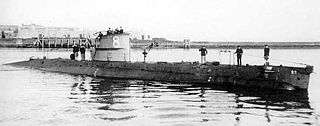
HMS H6 was a British H-class submarine of the Royal Navy built by Canadian Vickers & Co. during World War I.

The Dolfijn-class submarines of the Royal Netherlands Navy are a class of four submarines; Dolfijn, Zeehond, Potvis and Tonijn. They were built in the late 1950s and the early 1960s. They were the first indigenous submarines built in the Netherlands and for the Royal Netherlands Navy after World War II. In the Netherlands they are also known as "three cylinder" submarines.

The Royal Netherlands Navy Submarine Service is a department within the Royal Netherlands Navy that is responsible for the deployment of Dutch submarines. It was established out of the Netherlands Torpedo Service on 21 December 1906, and merged with the Netherlands Mine Service on 15 July 2005.
The O 2-class submarine consisted of four submarines built by Koninklijke Maatschappij De Schelde in Flushing for the Royal Netherlands Navy. Used for patrols in the Dutch home waters. The class comprised O 2, O 3, O 4 and O 5. Its diving depth was 25 metres (80 ft); during trials with no crew on board a depth of 40 metres (130 ft) was reached.
The O 9-class submarine consisted of three submarines, built for the Royal Netherlands Navy. Used for patrols in the Dutch home waters. The class comprised O 9, O 10, and O 11. Its diving depth was 60 metres (200 ft).

The O 12-class submarine consisted of four submarines built for the Royal Netherlands Navy. The ships, with a diving depth of 60 metres (200 ft), were used for patrols in the Dutch home waters. The class comprised O 12, O 13, O 14 and O 15. O 12 entered German service in 1943 as UD-2.

The O 19 class was a class of two submarines, built for the Royal Netherlands Navy by Fijenoord, Rotterdam. The ships were designed as submarine minelayer for operations in both European and colonies waters. The class comprised O 19 and O 20 and were the first submarines in the world to be equipped with a submarine snorkel that allowed the submarine to run its diesel engines while submerged. The submarines diving depth was 100 m (330 ft). These units were very similar to earlier Polish Orzeł class, with a reduced torpedo battery and 10 vertical mine tubes fitted on each beam.
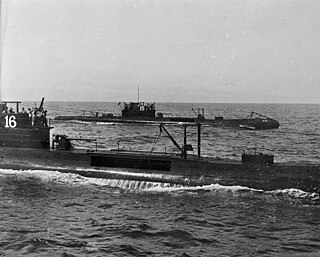
The K XIV class submarine was a class of five submarines, built for the Royal Netherlands Navy. Used for patrols in the Dutch colonial waters. The class comprised K XIV, K XV, K XVI, K XVII and K XVIII. The submarines diving depth was 80 m (260 ft). Three of the boats were lost in World War II.
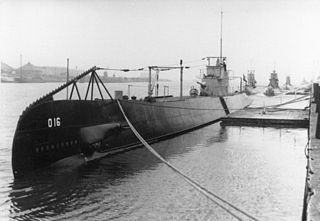
HNLMS O 16 was a submarine of the Royal Netherlands Navy that saw service during World War II. She was the first submarine of the RNN manufactured from high-quality Steel 52, with the ability to dive at a depth of 80 metres (260 ft).
O 6 was a unique patrol submarine of the Royal Netherlands Navy for European home waters. The ship was built by De Schelde shipyard in Flushing. The submarines diving depth was 40 metres. O 7 was very similar to the O 6 and they are sometimes regarded as one class.
HNLMS O 7 was a unique patrol submarine of the Royal Netherlands Navy for use in the home waters of Europe. The ship was built by the Maatschappij Fijenoord shipyard in Rotterdam. The submarines diving depth was 40 metres. O 6 was very similar to the O 7 and they are sometimes regarded as one class.

O 1 was a Holland 7P patrol submarine of the Royal Netherlands Navy. The ship was built by the De Schelde shipyard in Flushing and was the first submarine in the Dutch navy. It had a diving depth of 25 metres.

O 10 was a O 9-class patrol submarines of the Royal Netherlands Navy. The ship was built by Nederlandsche Scheepsbouw Maatschappij shipyard in Amsterdam.
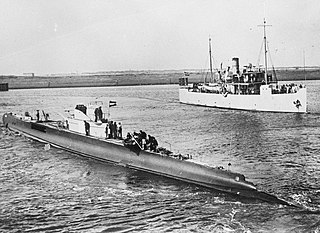
K XVII was one of five K XIV-class submarines built for the Royal Netherlands Navy. She served during World War II.

HNLMS Johan Maurits van Nassau (F802) was a River-class frigate of the Royal Netherlands Navy (RNN). She was built in the United Kingdom originally for the Royal Navy as HMS Ribble, however, during the construction the frigate was acquired by the RNN. She served in the RNN between 1943 and 1958.

HNLMS Krakatau was a minelayer of the Royal Netherlands Navy (RNN). She was built in the Dutch East Indies and served between 1924 and 1942 in the RNN.

HNLMS Pro Patria was a minelayer of the Royal Netherlands Navy (RNN). She was built in the Dutch East Indies and served between 1923 and 1942 in the RNN.
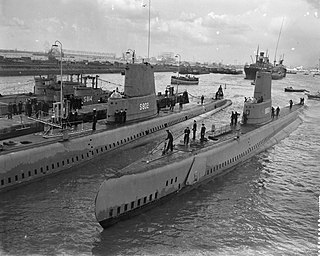
The Walrus class was a class of two submarines that served between 1953 and 1971 in the Royal Netherlands Navy. They were former Balao class submarines that were loaned to the Netherlands by the United States under the Mutual Defense Assistance Program (MDAP).















